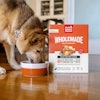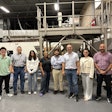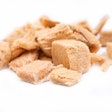Consumers are turning more and more to natural and organic products. By 2006, 98% of the US buying public reported purchasing a natural product, and 60% reported buying organic, says Information Resources Inc. (IRI). Those consumers who are also pet owners seem to be extending their purchasing habits to their pets' dietary needs.
According to Packaged Facts, sales of natural petfood in the US reached US$1 billion in 2007. This figure represents 6% of total US petfood sales and a whopping 50% total growth, or a compound annual growth rate (CAGR) of 25%, since 2003. Packaged Facts projects the segment to grow another 16% CAGR by 2012, increasing to more than US$2 billion.
In its report Natural, Organic and Eco-Friendly Pet Products in the US , released in October 2007, Packaged Facts says US sales of organic petfood have also increased at booming rates: 55% over 2006 and 48% CAGR since 2003. While still less than .5% of the total US petfood market, 2007 organic sales ended up at US$67 million, according to data from the Organic Trade Association. Packaged Facts projects that number to increase another 23% CAGR by 2012 to US$188 million.
Recalls and more
Besides growing consumer interest, Packaged Facts attributes these sales increases to other factors including:
- Continuing fallout from the 2007 US petfood recalls;
- Large petfood companies introducing natural brands in addition to ones from specialty marketers;
- The number and type of retail outlets carrying natural and organic products is expanding.
"Heightened consumer concerns over petfood safety stemming from the recalls in spring 2007 will keep consumer interest in natural and organic petfood high in the months and years ahead," predicts David Lummis, senior pet market analyst with Packaged Facts. "Looking across the hundreds of products directly involved in the recall, it cannot be chalked up to coincidence that almost all organic and high-grade natural petfoods were spared." He says the few natural products that were recalled fell victim to cross contamination rather than actually containing tainted ingredients, though he acknowledges exceptions such as Nutro products.
Though some petfood manufacturers point to a lack of scientific proof that natural and organic products are indeed healthier or safer, Lummis emphasizes that many natural petfoods and virtually all organic ones contain higher-quality ingredients and are produced in more closely monitored environments. In many cases, this is simply because the companies and production batches are much smaller, he adds.
According to Packaged Facts, other product categories benefiting from the recall fallout include raw/frozen, refrigerated, homemade, 100% US sourced and locally grownmany of which also bear labeling and marketing claims of natural or organic.
Big dogs moving in
Despite the preponderance of smaller petfood companies in the natural/organic category, brands such as Breeder's Choice, Castor & Pollux, Evanger's, Natural Balance, Newman's Own Organics and Old Mother Hubbard are often cited, one of the most significant shifts in the past few years has been the top five US petfood marketers entering this segment. "As of 2005, only two of the top marketers, Del Monte and Hill's (Colgate-Palmolive), offered natural brands, and both were restricted to the pet specialty channel," Lummis says.
Since then, the other top three marketers, Nestlé Purina, Mars and Iams (Procter & Gamble), have begun offering natural petfoods in both pet specialty and mass market retail outlets. Examples include Nestlé's Natural Blends extension of its Purina ONE line, Mars' Goodlife Recipe line and even Mars' purchase of Nutro in the wake of the 2007 recalls. All signs point to this trend continuing.
Beyond specialty stores
The expansion into natural and organic is not limited to the marketer side; US mass-market retailers are also getting in on the action. Since 2006 Wal-Mart, for example, has been adding related products, including Natural Life certified organic petfoods.
A June 2007 U.S. News & World Report article cites Food Marketing Institute data that about 75% of conventional US grocery stores, including major supermarket chains like Kroger, now sell organic food. This seems to spill over to petfood: According to IRI's Infoscan , sales of natural petfood in US mass-market outlets (supermarkets, drugstores and mass merchandisers except Wal-Mart) grew 236% in 2006, to US$29 million, then added US$57 million more during the first half of 2007.
In addition, Packaged Facts says pet retailers, including the "big box" chains, PetSmart and Petco, continue to offer more natural and organic petfoods. In the natural and organic retailing area, outlets from small to large, such as Whole Foods, are adding petfoods to their product mix.
Fueling the growth
Seeing all these positives, petfood manufacturers are adopting a strategy that has fueled overall sales growth: ramping up new product development. Datamonitor's Productscan Online service says that in the US in 2006, companies introduced 154 new petfood products with natural or organic claims, up from 111 in 2005. As of July 31, 2007, another 76 petfood products billed as natural and nine labeled organic had debuted.
Three times as many new natural and organic dog foods versus cat foods have been introduced, according to Packaged Facts. Its 2007 report also mentions that many of the new natural and organic petfoods are designed to help specific health conditions in pets, just as more mainstream petfood products are formulated to do.
Don't look for any of these trends to slow down anytime soon. Rightly or wrongly, many pet owners consider natural and organic petfoods the best way to feed their pets.


















